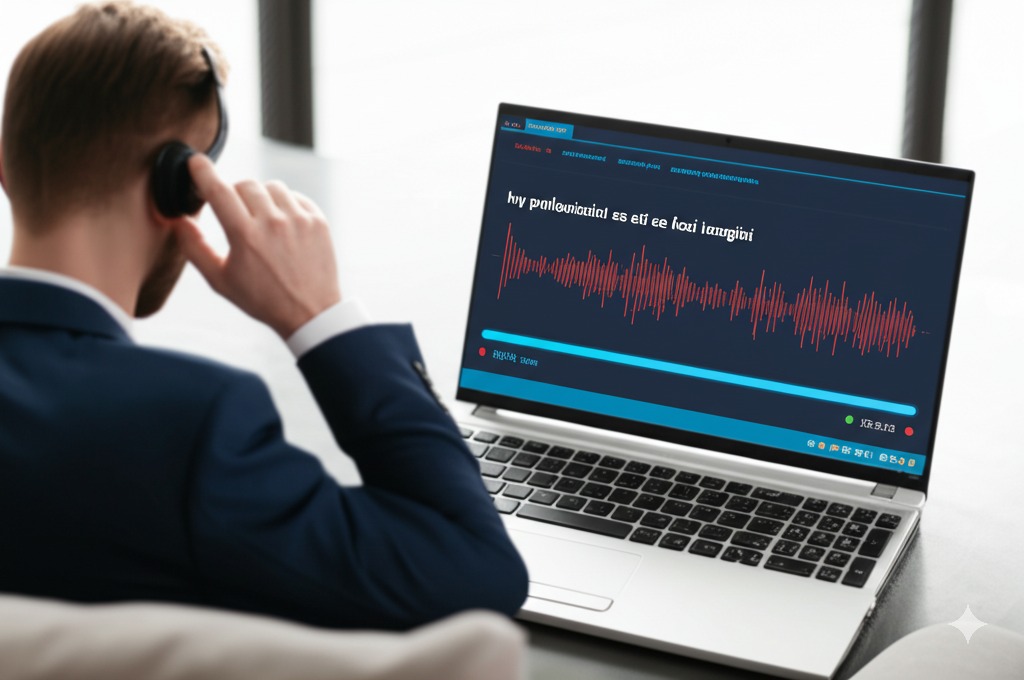
AI Text to Speech (TTS) for financial services converts written financial data into spoken words. This technology takes complex financial reports and transforms them into audio formats that clients can easily listen to. Banks and investment firms implement these systems by connecting TTS engines to their financial databases, creating workflows that automatically generate audio reports.
Financial institutions often struggle with client reporting. Traditional text-based reports are time-consuming to create and many clients find them difficult to understand. AI TTS for financial services solves these problems by turning financial information into clear, spoken explanations.
This technology helps financial companies deliver information more effectively. Clients can listen to their account updates or investment performance while doing other activities. Automating client reports makes financial information more accessible, especially for people who prefer listening over reading or who have visual impairments.
The automation of client reports through TTS also reduces costs for financial institutions. Instead of staff spending hours preparing written reports, computers can generate audio summaries automatically. This saves time and reduces the chance of human error in reporting.

Understanding AI Text to Speech for Finance
AI TTS for financial services takes written text and converts it into natural-sounding audio. In finance, this means turning numbers, market trends, and account information into spoken reports. The technology uses computer-generated voices that sound increasingly human.
Banks and investment firms use TTS because it helps people actually understand their money situation. Let’s be honest – most of us zone out when we see pages of numbers and financial jargon. But when someone explains it to us in plain language, it clicks. That’s what AI TTS for financial services does. Clients get the important stuff without drowning in details. They feel more in control of their finances, and they appreciate that their bank is making the effort to communicate clearly. This builds trust.
AI TTS for financial services offers several major benefits:
- It saves time by creating reports automatically
- It reduces costs by cutting down on paperwork
- It improves accuracy by eliminating manual errors
- It makes financial information accessible to more people
- It lets clients consume information on their own schedule
For example, think about getting your bank statement. Instead of a boring paper document full of numbers, you could get an audio file instead. This is what automating client reports looks like in practice – you could listen to it while driving and hear things like: “You spent less on groceries this month. Your retirement savings are growing nicely. That stock you bought went up 3%.” The smart AI text to speech solutions can even learn what you care about and focus on those things – maybe you’re really interested in saving for a vacation, so it gives you more details about that.
Key Components for AI Text to Speech in Financial Reporting
Setting up AI TTS for financial reporting requires several important elements working together.
Data Integration
First, the system needs access to financial data. This includes connecting to databases with transaction records, portfolio information, and market data. When automating client reports, the TTS system pulls this information automatically when creating reports.
Financial data must be properly formatted before it can be turned into natural language. This often involves cleaning the data and organizing it in ways that make sense for verbal communication.
Natural Language Generation
Raw financial data isn’t ready for TTS. It needs to be turned into proper sentences first. Natural Language Generation systems do this by taking numbers and data points and creating readable text.
For example, instead of just reading numbers, the system might say, “Your investment in Company X increased by 5% this month, adding $500 to your portfolio.”
Voice Technology
The voice technology component converts the text into spoken words. Modern TTS engines can produce natural-sounding speech with appropriate pauses, intonation, and emphasis.
Financial institutions can choose voices that match their brand and client preferences. Some even offer multiple voice options so clients can select the one they find most pleasant to listen to. For specialized applications, free AI voice cloning technologies allow institutions to create custom voices that align with their brand identity.
Delivery Channels
Once created, audio reports need to reach clients. Common delivery methods include:
- Mobile banking apps with audio playback features
- Email attachments with audio files
- Client portals where reports can be streamed
- Phone systems that can play reports when clients call in
- Smart speakers that can read financial information on command
For clients who frequently use mobile devices, AI text to speech mobile accessibility features ensure they can access their financial information anywhere.
Security and Compliance
Financial data is sensitive, so TTS systems must maintain strong security. This includes encryption for data storage and transmission, secure authentication for access, and audit trails to track usage.
The systems must also comply with financial regulations about how information is presented to clients. This might include requirements about disclosing certain information or maintaining records of communications.
How AI Text to Speech Automates Financial Client Reports
AI TTS for financial services follows a step-by-step process when Automating Client Reports:
- The system pulls data from financial databases at scheduled times
- It processes this data through analytics tools to identify trends and key points
- The natural language generator creates a script based on this analysis
- The TTS engine converts this script into spoken audio
- The system delivers this audio to clients through their preferred channels
This automation replaces many manual steps. Without TTS, financial advisors or report specialists would need to gather data, create reports, proofread them, format them, and send them to clients. This takes hours of work for each report.
With automated TTS reports, financial institutions can provide more frequent updates without increasing staff workload. They can also customize reports for different client segments without significantly more effort.

Best AI Text to Speech Software for Financial Services
When choosing AI TTS for financial services, institutions have several strong options:
- Amazon Polly – Offers specialized voices for financial reporting and integrates well with existing banking systems
- IBM Watson Text to Speech – Provides highly natural voices with financial terminology pronounciation
- Microsoft Azure Text to Speech – Features customizable voices and strong security protocols
- Google Cloud Text to Speech – Offers multilingual support for global financial institutions
The right choice depends on factors like budget, existing infrastructure, language requirements, and security needs. Most providers offer free trials that let financial institutions test voice quality and integration capabilities before committing.
Real-World Use Cases of AI TTS in Financial Services
Several major financial institutions have already implemented AI TTS solutions with impressive results.
National Australia Bank’s Voice Banking System
National Australia Bank uses Amazon’s Text to Speech technology to help clients access their financial information through voice commands. The system can provide account balances, recent transactions, and spending analyses through audio reports.
Clients can access these voice reports through the bank’s mobile app or through smart speakers at home. This has increased client engagement with financial information and improved satisfaction scores.
Source: National Australia Bank Case Study
IBM Watson at European Investment Bank
European Investment Bank uses IBM Watson Text to Speech to create personalized audio reports for their major clients. These reports summarize investment performance, market analyses, and recommended actions.
The bank has seen a 35% increase in clients reviewing their financial information since implementing the audio report option. Clients particularly appreciate being able to listen to updates while commuting or traveling.
Source: IBM Case Studies
Securely Automating Client Communication With AI Voice Technology
Security is a top priority when implementing automated reporting systems in finance. Financial institutions take several steps to ensure client data remains protected:
- End-to-end encryption for all audio reports
- Multi-factor authentication for accessing financial voice reports
- Secure storage systems for both text and audio files
- Regular security audits and penetration testing
- Strict access controls limiting who can generate reports
These security measures protect sensitive financial information while still allowing for convenient audio delivery. Banks can also use voice SEO and TTS optimizing content techniques to make information both secure and easily accessible.
Benefits of Using AI TTS for Investment Report Generation
Financial institutions that implement AI TTS for financial services for report generation see numerous benefits:
Time Savings
Creating client reports traditionally takes hours of staff time. With TTS automation, reports can be generated in minutes. This frees up financial advisors to focus on more valuable work like providing personalized advice.
Cost Reduction
The cost savings of AI TTS in financial report delivery can be substantial. Banks report saving between 40-60% on reporting costs after implementing automatic voice reporting systems.
These savings come from reduced paper and printing costs, fewer staff hours devoted to report creation, and lower distribution expenses. Over time, these savings often exceed the initial investment in TTS technology. For organizations concerned about implementation costs, free text to speech costs resources can help estimate potential savings.
Better Client Understanding
Financial information can be complex. When delivered as audio, clients often understand it better than when reading technical documents. Voice reports can explain concepts in conversational language and emphasize the most important points.
Accessibility
For clients with visual impairments or reading difficulties, voice reports make financial information accessible in ways that traditional reports cannot. This helps financial institutions serve a wider range of clients and comply with accessibility requirements.
Personalization
AI TTS systems can create personalized voice reports for wealth management clients by tailoring content to their specific situations. The system might emphasize different aspects of performance based on known client priorities or explain concepts in more or less detail based on client sophistication.
Integration with Existing Financial Reporting Systems
Most financial institutions already have reporting systems in place. Integrating AI TTS with existing financial reporting systems typically involves adding new components rather than replacing current infrastructure.
The integration process usually follows these steps:
- Connect TTS systems to existing data sources
- Create templates for converting report data to natural language
- Set up testing environments to verify accuracy
- Establish delivery mechanisms for audio reports
- Create monitoring systems to track usage and performance
Many financial software vendors now offer TTS modules that can be added to existing platforms. This makes integration simpler than building custom solutions from scratch. Some institutions are even exploring how to create an AI voice assistant for website integration to further enhance client experience.

Speech Synthesis in Financial Applications
Speech synthesis has gotten much better lately. The robot voices of the past are gone. Now, financial companies can use voices that sound like real people talking. These new voices know how to say tricky financial words correctly.
The newest TTS systems can change how they talk based on what they’re saying. They’ll use a serious voice when telling you about important account changes or warnings. But for regular updates about your investments, they’ll sound more friendly and casual. This helps you understand right away if something needs your attention or if it’s just a routine update.
Regulatory Compliance for Automated Voice-Based Financial Communication
Financial services are heavily regulated, and regulatory compliance for automated voice-based financial communication is essential.
Key compliance considerations include:
- Ensuring all required disclosures are included in audio reports
- Maintaining records of what information was provided to which clients
- Providing written alternatives for clients who prefer them
- Securing sensitive financial data throughout the TTS process
- Ensuring the accuracy of information presented in audio format
Working with compliance officers from the beginning of implementation helps ensure that voice reports meet all regulatory requirements. This may involve creating specific templates that include all required disclosures and implementing approval workflows for automated content.
The Future of AI Text to Speech in the Banking Industry
The future of AI text to speech in the banking industry looks promising. Several emerging trends will shape how this technology evolves:
More Natural Voices
AI voices are becoming increasingly natural and expressive. Future systems will be nearly indistinguishable from human voices, making the listening experience more pleasant. Development of emotional AI voice technology will further enhance the client experience.
Multilingual Support
Generating multilingual financial reports using AI TTS will become standard. Banks with international clients will automatically create reports in clients’ preferred languages.
Interactive Voice Reports
Future systems will allow clients to interact with their reports, asking questions for clarification or requesting more details on specific points.
Voice Biometrics
For security, voice recognition will verify client identity before playing sensitive financial information.
Integration with Voice Assistants
Banking reports will be accessible through popular voice assistants, allowing clients to request financial updates through devices they already use daily.
For those interested in broader applications, future trends in text to speech industry offers insights into where this technology is heading.
AI in Finance: Beyond Report Generation
AI TTS for financial services extends beyond just creating audio reports. The same technology is being used for:
- Voice-based fraud detection systems that can identify suspicious patterns in transactions
- Automated financial advisors that provide basic guidance through voice interactions
- Interactive voice response systems for customer service
- Training simulations for new financial advisors
- Market analysis tools that provide verbal summaries of trends
Financial institutions that embrace AI voice technology gain advantages across multiple areas of operation, not just in client reporting.
How to Get Started with AI TTS for Financial Reporting
Financial institutions interested in implementing AI TTS for financial services for client reporting should follow these steps:
- Assess current reporting needs and identify which reports would benefit most from audio versions
- Evaluate available TTS solutions and their integration requirements
- Start with a pilot program for a small client segment to test effectiveness
- Gather feedback and refine the approach before full implementation
- Train staff on the new systems and how to support clients using them
- Gradually expand to more report types and client segments
Starting small allows financial institutions to learn what works best for their specific needs before making major investments. Those looking to explore various options might start with free text to voice solutions to test the concept before investing in enterprise-grade systems.
Client Communication Transformed by Voice Technology
Client communication in financial services has traditionally relied on written documents, phone calls, and face-to-face meetings. Automating client reports with AI TTS adds a new channel that combines the convenience of digital communication with the personal touch of voice.
This transformation makes financial information more accessible and engaging. Clients who previously ignored written reports often listen to audio versions, leading to better financial awareness and decision-making.
The technology also helps financial institutions maintain regular contact with clients without increasing staff workload. This consistent communication builds stronger client relationships and increases retention.

FAQs about AI TTS for Financial Services
What is AI Text to Speech (TTS)?
AI TTS for financial services is technology that turns written words into spoken language. It uses computer programs to create human-like voices that read text aloud. Modern TTS sounds very natural and can pronounce complex financial terms correctly.
How can AI TTS improve client reporting in finance?
Automating client reports with AI TTS makes financial reports easier to understand and more convenient for clients. Instead of reading long documents full of numbers, clients can listen to the key information while doing other things. This leads to better understanding of their financial situation and saves time for both clients and financial institutions.
Is AI TTS secure for handling sensitive financial data?
Yes, when set up properly. Financial TTS systems use strong encryption, require secure login methods, and limit who can access the information. Banks and investment firms follow strict security rules to keep client data safe when creating and delivering voice reports.
Can AI TTS deliver personalized reports?
Absolutely. Modern TTS systems can create custom reports based on each client’s specific accounts, investments, and preferences. The system can highlight information that matters most to that particular client and explain things in more or less detail based on their knowledge level.
Will AI TTS replace human financial advisors?
No. AI TTS is a tool that helps advisors communicate better with clients, not a replacement for human expertise. Voice reports handle routine updates, freeing advisors to focus on more valuable work like personal guidance, complex planning, and building relationships.
What are some real-world applications of TTS in finance?
Several major banks already use TTS successfully. National Australia Bank provides voice banking through smart speakers and apps. European Investment Bank creates personalized audio reports that summarize investment performance. These examples show how TTS helps real financial institutions serve their clients better.
How can financial institutions get started with AI TTS for reporting?
Start small. First, identify which reports clients find most difficult to understand. Then test TTS with a small group of clients to see what works. Get their feedback, make improvements, and gradually expand to more reports and clients. Many TTS providers offer starter packages that make it easy to begin without a huge investment.
Conclusion about AI TTS for Financial Services
AI TTS for financial services is changing how banks and investment firms talk to their clients. By turning complex financial reports into easy-to-understand audio, these systems make important information more accessible to everyone.
Financial companies that use TTS save money, reduce errors, and free up their staff to focus on more important work. Clients benefit by getting information in a format they can easily use while doing other activities.
As TTS technology keeps improving, we’ll see more natural voices, interactive features, and better security. Banks that adopt these tools now will build stronger relationships with their clients and stay ahead of competitors.
For financial institutions looking to improve client communication, AI Text to Speech offers a practical solution that benefits both the business and its customers.

